Impact of Acetylation on the Behaviour of Single-Dowel Timber Connections
Abstract
:1. Introduction
1.1. Background and Motivation
1.2. Previous Work
1.3. Aim
2. Materials and Methods
2.1. Material
2.2. Embedment Strength
2.3. Dowel-Type Connections
2.3.1. Parallel to the Grain Loading
2.3.2. Perpendicular to the Grain Loading
2.3.3. Evaluation of Connection Brittleness
2.4. Comparison with Eurocode 5
3. Results
3.1. Embedment Strength
3.2. Parallel to the Grain Loading
3.3. Perpendicular to the Grain Loading
4. Discussion
5. Further Research
6. Concluding Remarks
- Compared to untreated wood, acetylated Scots pine demonstrated a significantly increased embedment strength parallel to the grain, while no difference for embedment strength could be found for perpendicular to the grain loading.
- For acetylated wood, using the measured density in combination with the EC5 approach provided reasonably conservative estimations of the embedment strength perpendicular to the grain (). However, the embedment strength parallel to the grain was severely underestimated ().
- For dowel-type connections loaded parallel to the grain, acetylated wood demonstrated an increased load-bearing capacity compared to untreated wood.
- Using the EC5 approach, a conservative estimation of the load-bearing capacity for dowel-type connections parallel to the grain was obtained. However, connections made from acetylated wood failed in a brittle manner. To achieve ductile responses but at the same time utilize the full potential of increased embedment strength, reinforced joints are recommended.
- The load-bearing capacity of dowel-type connections loaded perpendicular to the grain was lower for acetylated wood compared to untreated wood.
Author Contributions
Funding
Data Availability Statement
Acknowledgments
Conflicts of Interest
References
- Schoenmakers, J.C.M. Fracture and Failure Mechanisms in Timber Loaded Perpendicular to the Grain by Mechanical Connections. Ph.D. Thesis, Technische Universiteit Eindhoven, Eindhoven, The Netherlands, 2010. [Google Scholar]
- Ehlbeck, J.; Görlacher, R. E11 Joints Loaded Perpendicular to the Grain. In Timber Engineering—Principles for Design; Blass, H.J., Sandhaas, C., Eds.; KIT Scientific Publishing: Karlsruhe, Germany, 2017; pp. 441–457. [Google Scholar]
- EN 1995-1-1; Eurocode 5: Design of timber structures: Part 1-1, General—Common rules and rules for buildings. European Union: Brussels, Belgium, 2004.
- Van der Put, T.; Leijten, A. Evaluation of perpendicular to grain failure of beams caused by concentrated loads of joints. In Proceedings of the International Council for Research and Innovation in Building and Construction, CIB-W18 Meeting 33, Delft, The Netherlands, 28–30 August 2000. [Google Scholar]
- Van der Put, T. Tension perpendicular to grain at notches and connections. In Proceedings of the International Council for Research and Innovation in Building and Construction, CIB-W18 Meeting 23, Lissboa, Portugal, 10–14 September 1990. [Google Scholar]
- Leijten, A.; Jorissen, A. Splitting strength of beam loaded by connections perpendicular to grain, model validation. In Proceedings of the International Council for Research and Innovation in Building and Construction, CIB-W18 Meeting 34, Venice, Italy, 22–24 August 2001. [Google Scholar]
- Larsen, H.; Gustafsson, P. Dowel joints loaded perpendicular to grain. In Proceedings of the International Council for Research and Innovation in Building and Construction, CIB-W18 Meeting 34, Venice, Italy, 22–24 August 2001. [Google Scholar]
- Johansen, K. Theory of timber connections. Int. Assoc. Bridge Strucural Eng. 1949, 9, 249–262. [Google Scholar]
- Jorissen, A.J.M. Double Shear Timber Connections with Dowel Type Fasteners. Ph.D. Thesis, Technische Universiteit Delft, Delft, The Netherlands, 1998. [Google Scholar]
- Reiterer, A.; Sinn, G.; Stanzl-Tschegg, S. Fracture characteristics of different wood species under mode I loading perpendicular to the grain. Mater. Sci. Eng. A 2002, 332, 29–36. [Google Scholar] [CrossRef]
- Forsman, K.; Serrano, E.; Danielsson, H.; Engqvist, J. Fracture characteristics of acetylated young Scots pine. Eur. J. Wood Wood Prod. 2020, 78, 693–703. [Google Scholar] [CrossRef]
- Dreher, W.; Goldstein, I.; Cramer, G. Mechanical Properties of Acetylated Wood. For. Prod. J. 1964, 14, 66–68. [Google Scholar]
- Rowell, R.M. Chemical modification of wood: A short review. Wood Mater. Sci. Eng. 2006, 1, 29–33. [Google Scholar] [CrossRef]
- Larsson Brelid, P. Benchmarking and State of the Art for Modified Wood; SP Technical Research Institute of Sweden: Borås, Sweden, 2013. [Google Scholar]
- ASTM D143-52; Standard Methods of Testing of Small Clear Specimens of Timber. American Society for Testing and Materials: West Conshohocken, PA, USA, 1952.
- Gustafsson, P.J. Fracture Perpendicular to Grain—Structural Applications. In Timber Engineering; Thelandersson, S., Larsen, H.J., Eds.; John Wiley & Sons: Chichester, UK, 2003; pp. 103–130. [Google Scholar]
- Reiterer, A.; Sinn, G. Fracture behaviour of modified spruce wood: A study using linear and non linear fracture mechanics. Holzforschung 2002, 56, 191–198. [Google Scholar] [CrossRef]
- Lai, G.; Plönning, S. Fracture Characteristics of Acetylated Birch—Experimental and Numerical Studies. Master’s Thesis, Division of Structural Mechanics, Faculty of Engineering LTH, Lund University, Lund, Sweden, 2019. [Google Scholar]
- Forsman, K.; Fredriksson, M.; Serrano, E.; Danielsson, H. Moisture-dependency of the fracture energy of wood: A comparison of unmodified and acetylated Scots pine and birch. Holzforschung 2021, 75, 731–741. [Google Scholar] [CrossRef]
- Guo, J.; Wang, C.; Li, C.; Liu, Y. Effect of Acetylation on the Physical and Mechanical Performances of Mechanical Densified Spruce Wood. Forests 2022, 13, 1620. [Google Scholar] [CrossRef]
- Anderberg, S. Mechanical Properties of Chemical Modified Wood of Load-Bearing Constructions. Master’s Thesis, Division of Structural Engineering, Faculty of Engineering LTH, Lund University, Lund, Sweden, 2016. [Google Scholar]
- Wang, Y.; Wang, T.; Crocetti, R.; Schweigler, M.; Wålinder, M. Embedment behavior of dowel-type fasteners in birch plywood: Influence of load-to-face grain angle, test set-up, fastener diameter, and acetylation. Constr. Build. Mater. 2023, 384, 131440. [Google Scholar] [CrossRef]
- Giotra, K. Process for Wood Acetylation and Product Thereof. European Patent 2818287A1, 31 December 2014. [Google Scholar]
- Schwanninger, M.; Stefke, B.; Hinterstoisser, B. Qualitative assessment of acetylated wood with infrared spectroscopic methods. J. Infrared Spectrosc. 2011, 19, 349–357. [Google Scholar] [CrossRef]
- Thybring, E.E. The decay resistance of modified wood influenced by moisture exclusion and swelling reduction. Int. Biodeterior. Biodegrad. 2013, 82, 87–95. [Google Scholar] [CrossRef]
- ISO 10984-2; Timber Structures—Dowel-Type Fasteners—Part 2: Determination of Embedding Strength and Foundation Values. International Organization for Standardization: Geneva, Switzerland, 2009.
- Smith, I.; Asiz, A.; Snow, M.; Chui, Y. Possible Canadian/ISO approach to deriving design values from test data. In Proceedings of the International Council for Research and Innovation in Building and Construction, CIB-W18 Meeting, Florence, Italy, 28–31 August 2006. [Google Scholar]
- Hillerborg, A. The theoretical basis of a method to determine the fracture energy GF of concrete. Mater. Struct. 1985, 18, 291–296. [Google Scholar] [CrossRef]
- Blaß, H.J.; Schädle, P. Ductility aspects of reinforced and non-reinforced timber joints. Eng. Struct. 2011, 33, 3018–3026. [Google Scholar] [CrossRef]
- Jensen, J.L.; Girhammar, U.A.; Quenneville, P.; Källsner, B. Splitting of beams loaded perpendicular to grain by connections: Simple fracture mechanics models. In Proceedings of the World Conference on Timber Engineering, Auckland, New Zealand, 15–19 July 2012; New Zealand Timber Design Society: Wellington, New Zealand, 2012; pp. 388–397. [Google Scholar]
- Yasumura, M. Determination of fracture parameter for dowel-type joints loaded perpendicular to wooden grain and its application. In Proceedings of the International Council for Research and Innovation in Building and Construction, CIB-W18 Meeting 35, Kyoto, Japan, 16–19 September 2002. [Google Scholar]
- Danielsson, H.; Gustafsson, P.J. Fracture analysis of perpendicular to grain loaded dowel-type connections using a 3D cohesive zone model. Wood Mater. Sci. Eng. 2016, 11, 261–273. [Google Scholar] [CrossRef]
- Marcroft, J.; Bongers, F.; Perez, F.; Alexander, J.; Harrison, I. Structural Performance of Accoya® Wood under Service Class 3 Conditions. In Materials and Joints in Timber Structures; RILEM Bookseries; Aicher, S., Reinhardt, H., Garrecht, H., Eds.; Springer: Dordrecht, Germany, 2014; Volume 9. [Google Scholar] [CrossRef]
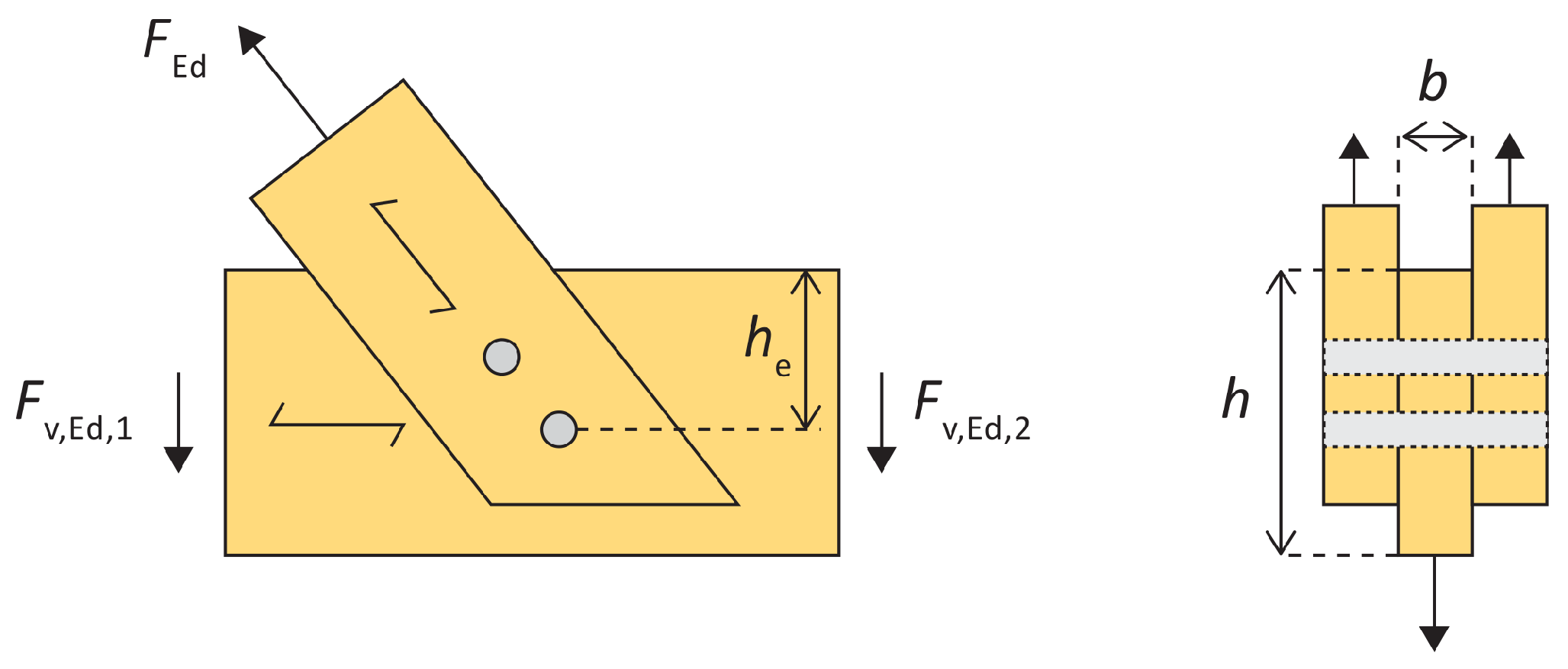

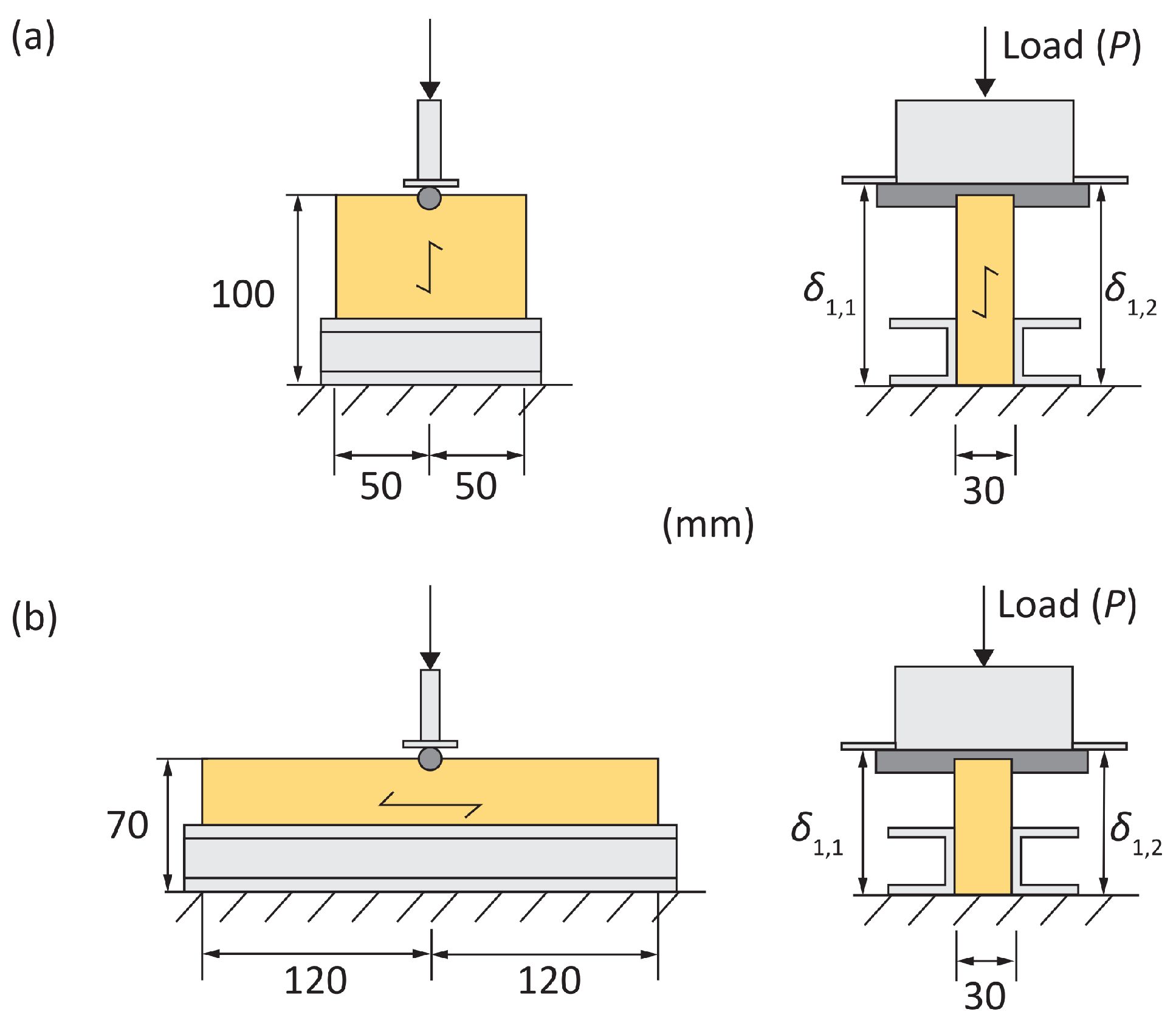
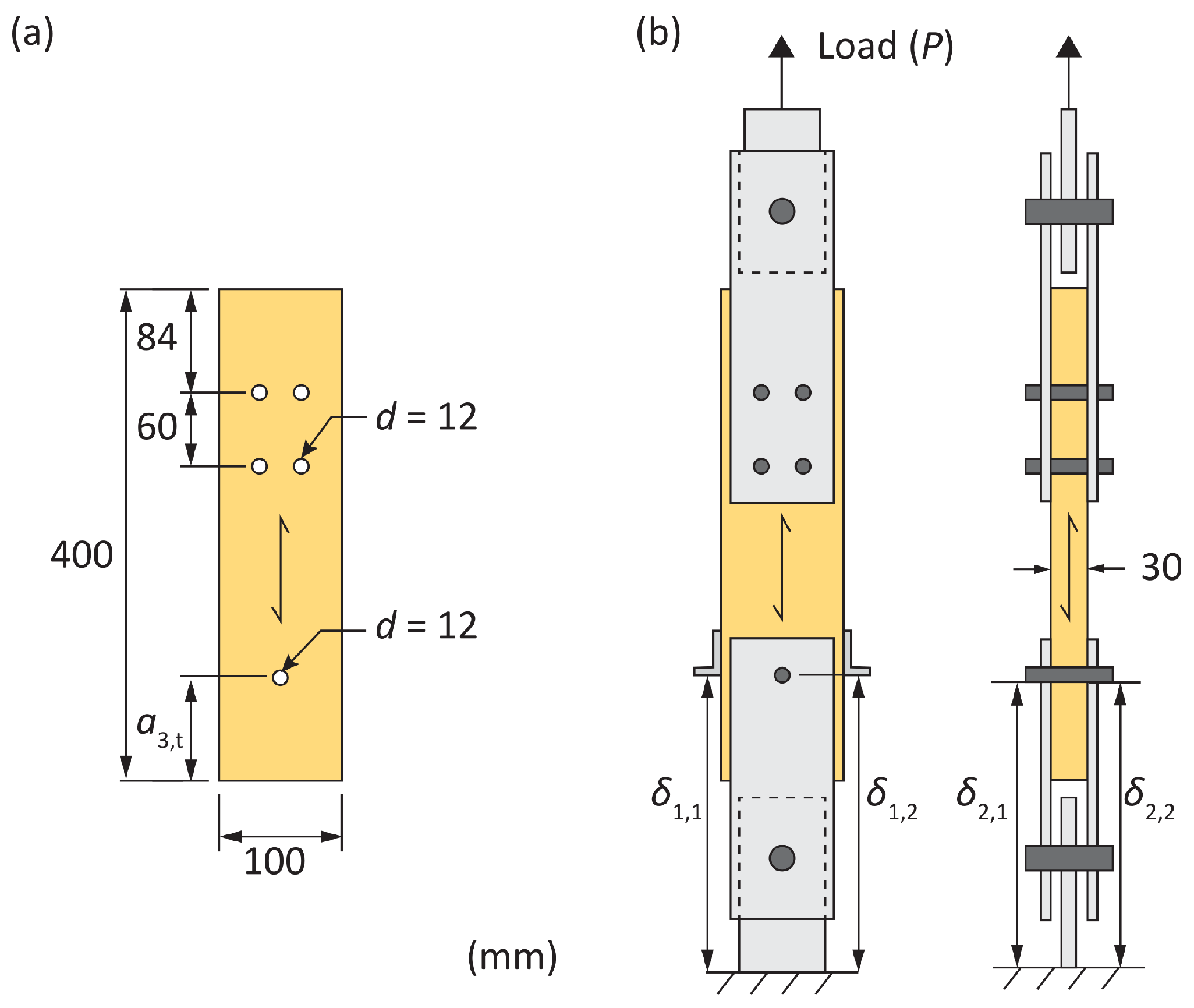

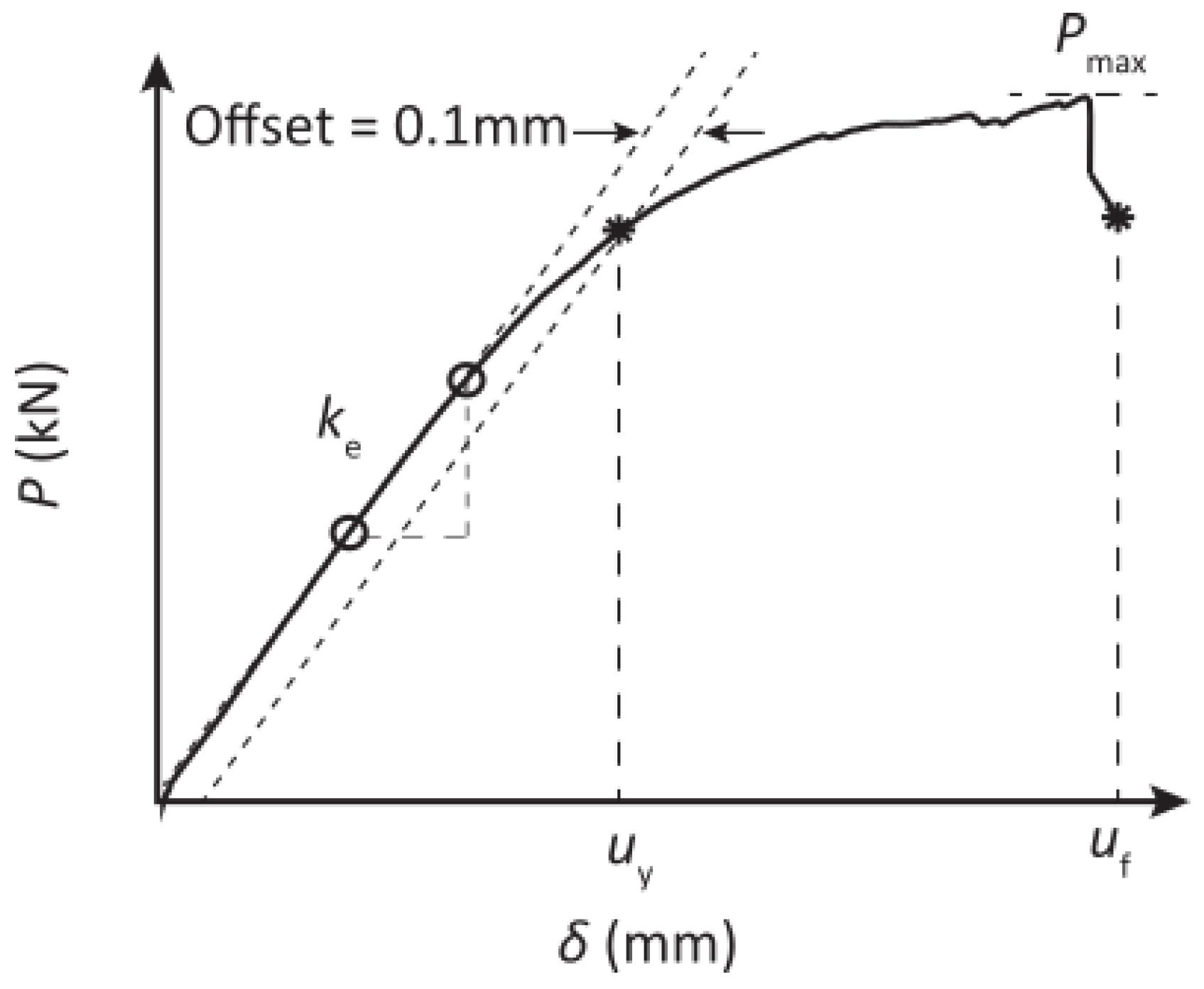
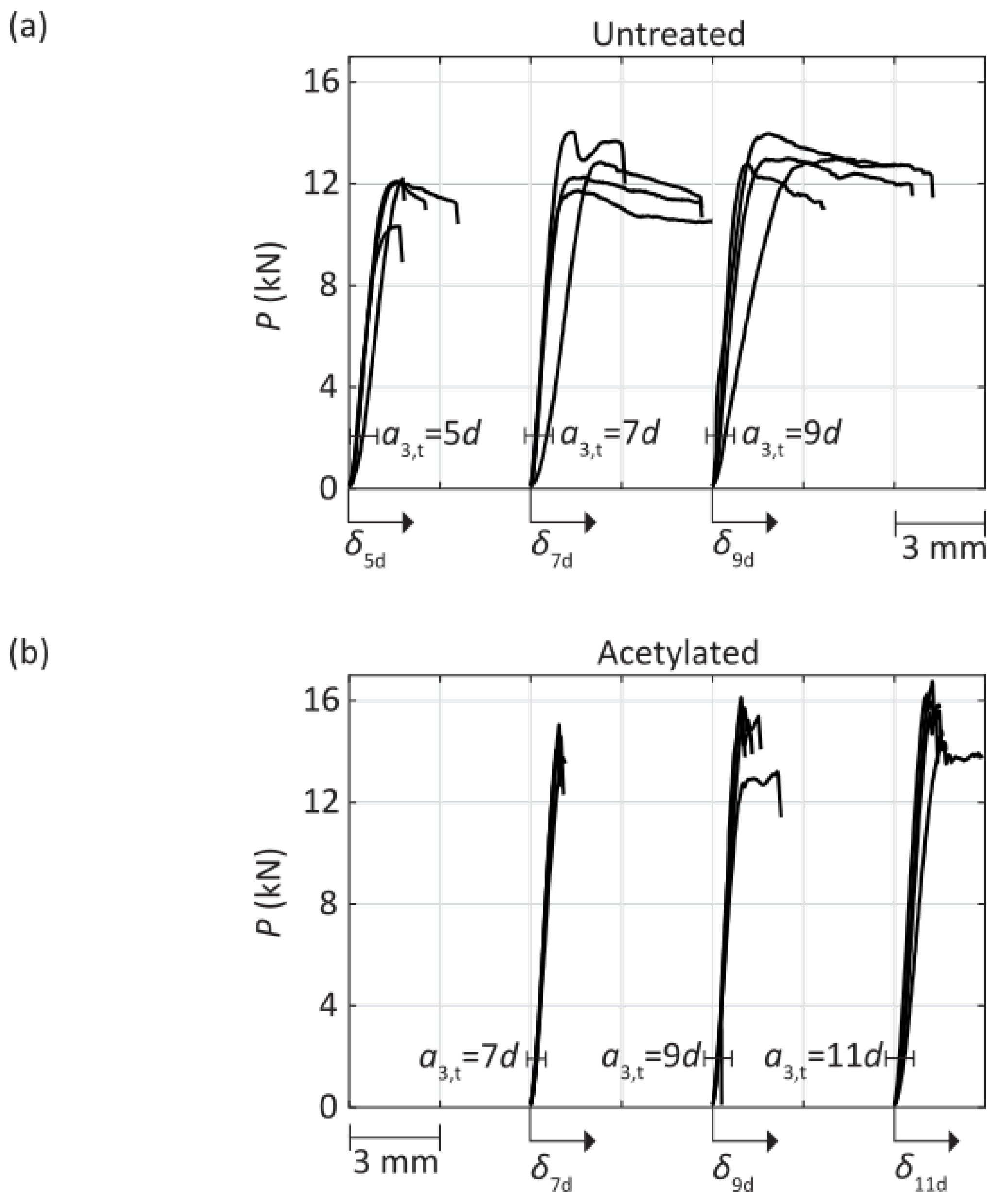
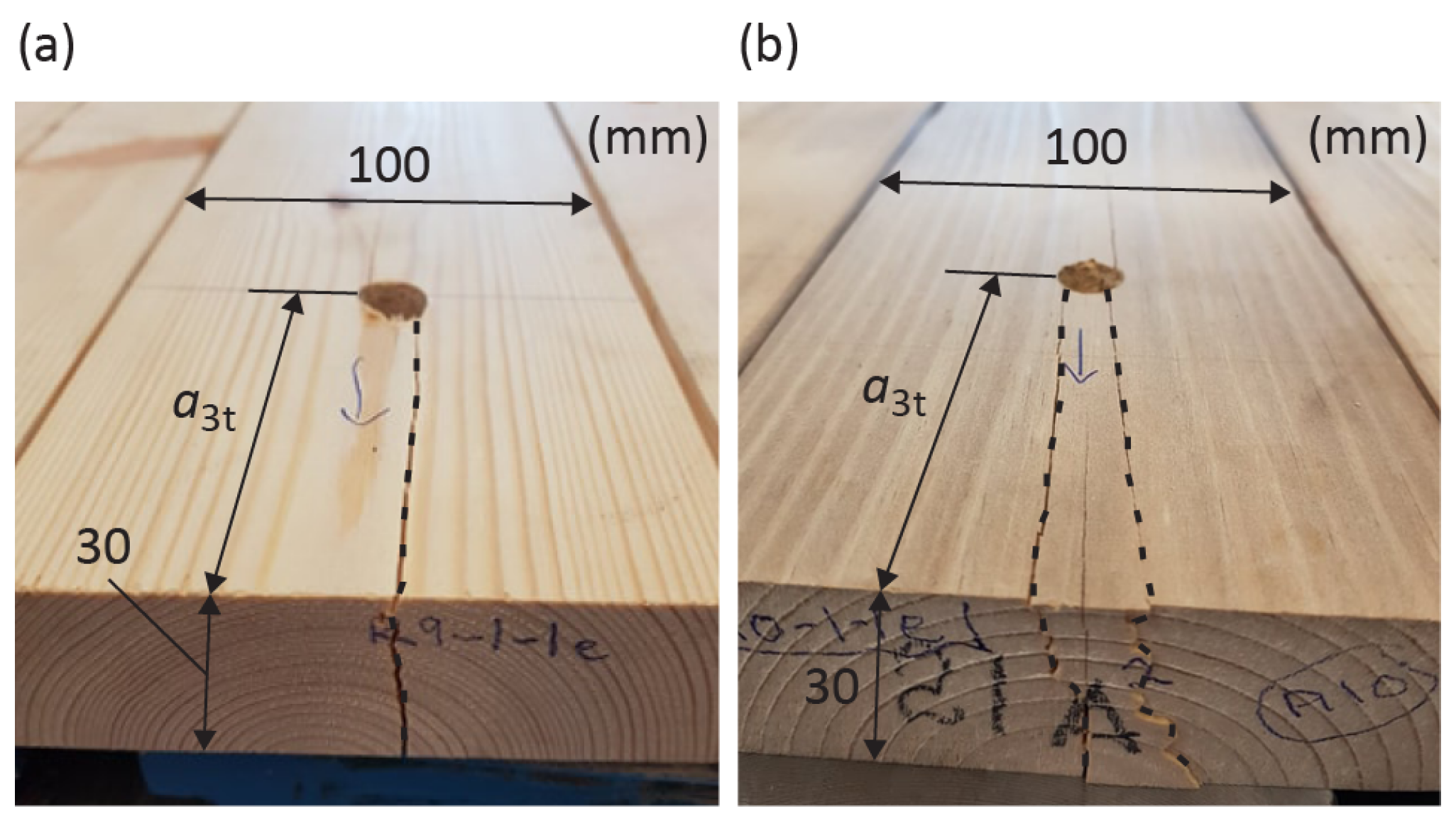
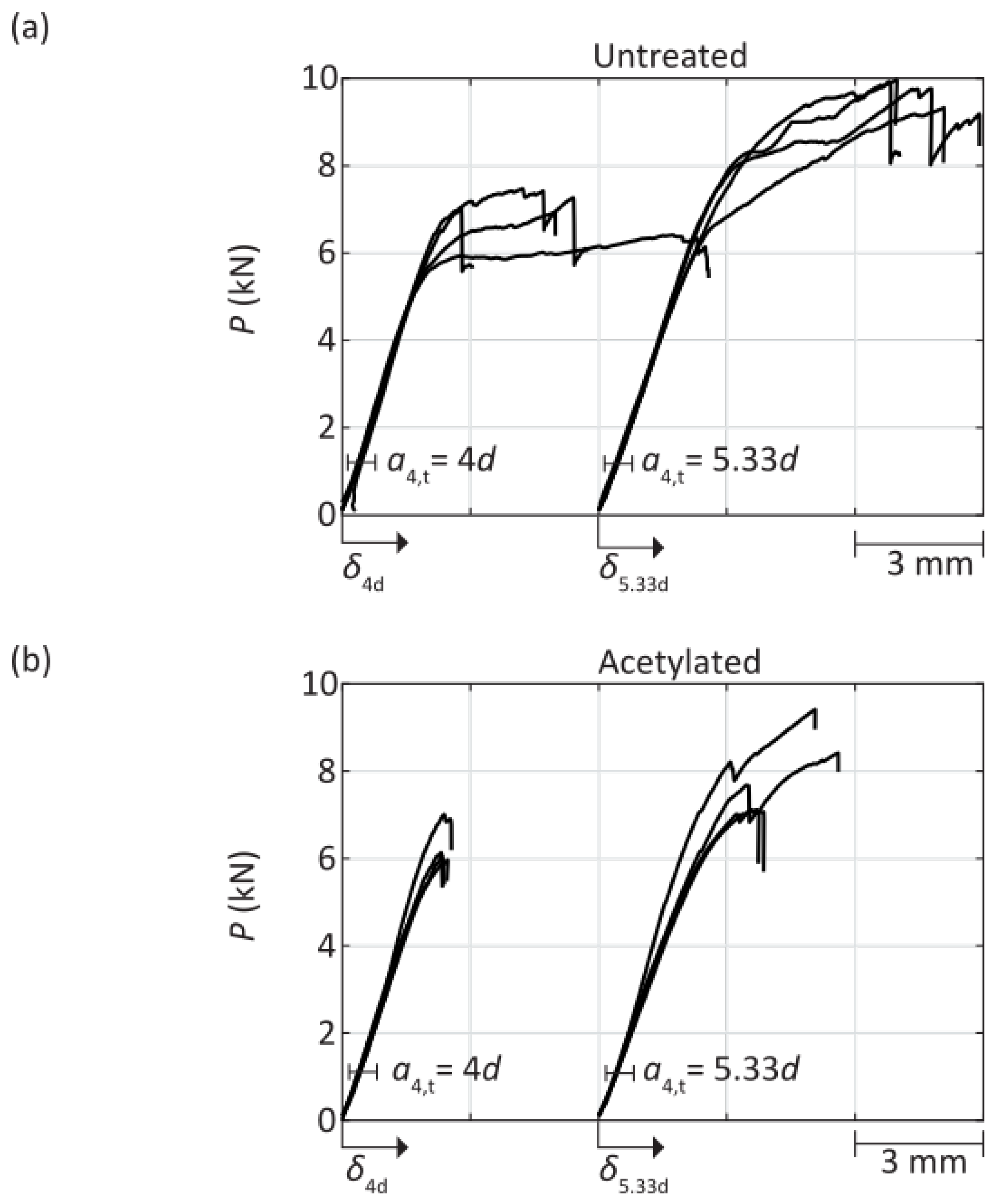

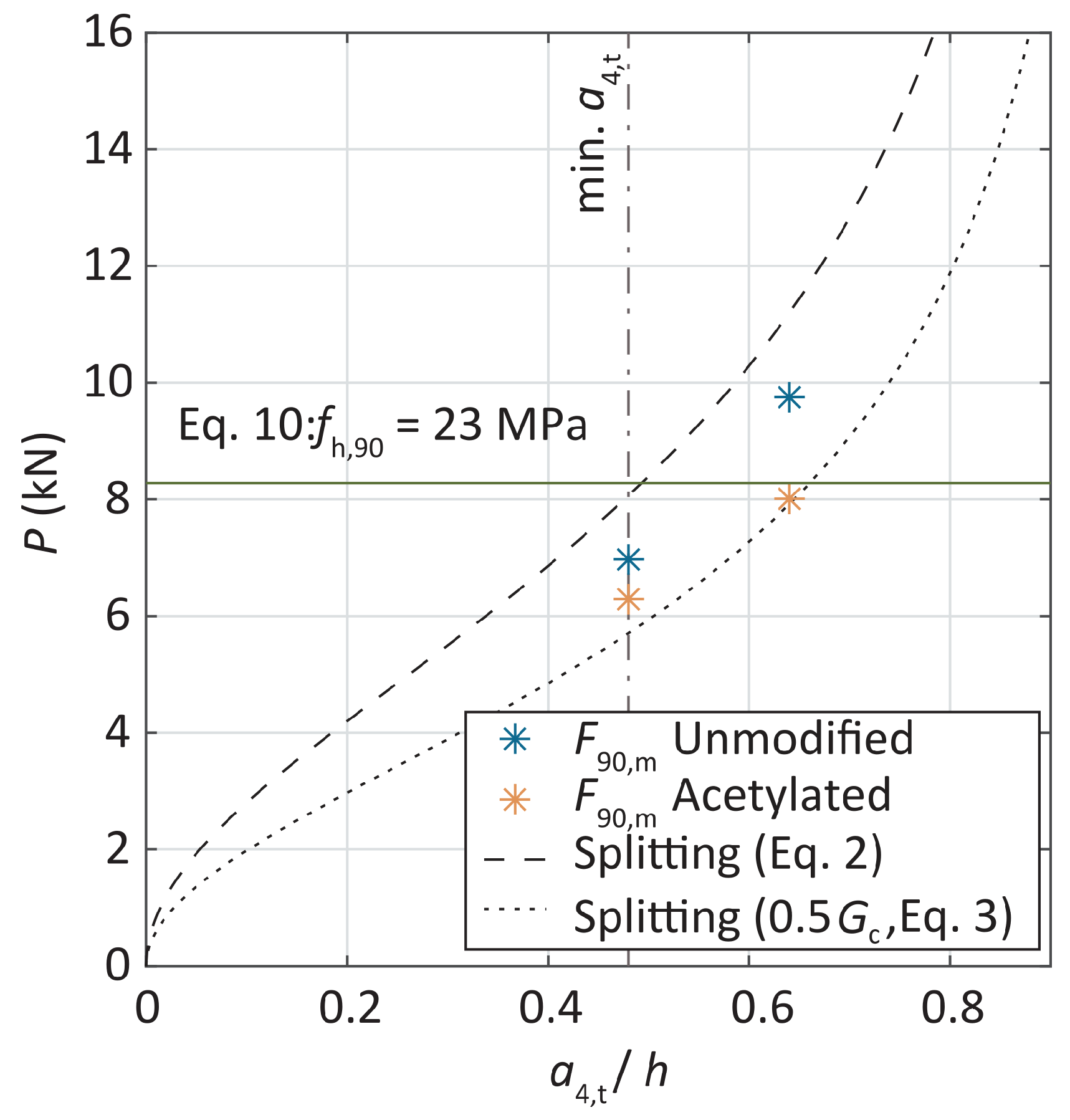
| Untreated | 4 | 4 | 4 | - |
| Acetylated | - | 4 | 4 | 4 |
| Untreated | 4 | 4 |
| Acetylated | 4 | 4 |
| Parallel | Untreated | 36 | 35 | 0.97 |
| ( = 0°) | Acetylated | 47 | 36 | 0.76 |
| + 31% * | ||||
| Perpendicular | Untreated | 24 | 23 | 0.95 |
| ( = 90°) | Acetylated | 26 | 23 | 0.89 |
| +8% |
| Untreated | 2.2 | 5.0 | 4.9 | - |
| Acetylated | - | 1.1 | 1.7 | 1.7 |
| Untreated | 11.7 | 12.7 | 13.2 | - | |
| 1.1 | 1.0 | 0.98 | - | ||
| 1.1 | 0.99 | 0.95 | - | ||
| Acetylated | - | 14.4 | 15.2 | 15.7 | |
| - | 1.2 | 1.1 | 1.1 | ||
| - | 0.89 | 0.84 | 0.82 | ||
| +13% * | +15% * | ||||
| Untreated | 3.1 | 3.0 |
| Acetylated | 1.3 | 2.0 |
| Untreated | 6.97 | 9.75 | |
| 1.2 | 0.89 | ||
| 1.2 | 0.84 | ||
| Acetylated | 6.29 | 8.01 | |
| 1.5 | 1.2 | ||
| 1.3 | 1.1 | ||
| −10% | −18% * | ||
Disclaimer/Publisher’s Note: The statements, opinions and data contained in all publications are solely those of the individual author(s) and contributor(s) and not of MDPI and/or the editor(s). MDPI and/or the editor(s) disclaim responsibility for any injury to people or property resulting from any ideas, methods, instructions or products referred to in the content. |
© 2024 by the authors. Licensee MDPI, Basel, Switzerland. This article is an open access article distributed under the terms and conditions of the Creative Commons Attribution (CC BY) license (https://creativecommons.org/licenses/by/4.0/).
Share and Cite
Forsman, K.; Serrano, E.; Danielsson, H. Impact of Acetylation on the Behaviour of Single-Dowel Timber Connections. Buildings 2024, 14, 405. https://doi.org/10.3390/buildings14020405
Forsman K, Serrano E, Danielsson H. Impact of Acetylation on the Behaviour of Single-Dowel Timber Connections. Buildings. 2024; 14(2):405. https://doi.org/10.3390/buildings14020405
Chicago/Turabian StyleForsman, Karin, Erik Serrano, and Henrik Danielsson. 2024. "Impact of Acetylation on the Behaviour of Single-Dowel Timber Connections" Buildings 14, no. 2: 405. https://doi.org/10.3390/buildings14020405





